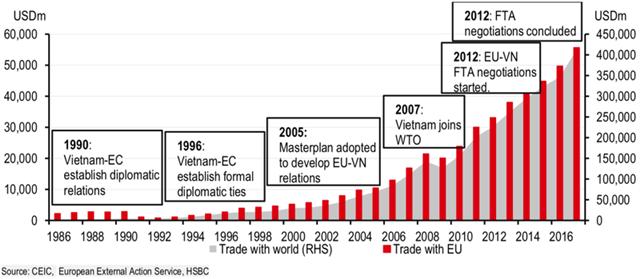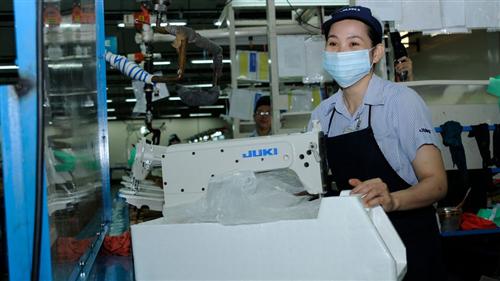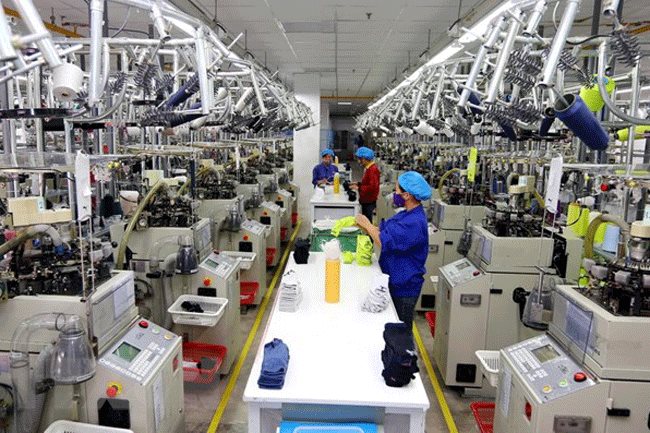EVFTA to open up unprecedented opportunities for Vietnam and EU
EVFTA to open up unprecedented opportunities for Vietnam and EU
The agreement, concluded after six years of negotiations, has been dubbed “the most ambitious” FTA the EU has ever reached with a developing country.
The EU – Vietnam Free Trade Agreement (EVFTA) is expected to open up unprecedented opportunities for Vietnam and EU as the European Parliament is set to ratify the trade deal and the EU – Vietnam Investment Protection Agreement (EVIPA) today (February 12).

|
Opportunites for both sides
The agreement, concluded after six years of negotiations, has been dubbed “the most ambitious” FTA the EU has ever reached with a developing country, according to the European Commission.
It not only includes the almost full elimination of bilateral tariffs, but also a substantial reduction of non-tariff barriers. Moreover, it includes provisions to protect intellectual property, labor, environmental standards, and fair competition, while promoting regulatory coherence.
In a statement, Member of the European Parliament Iuliu Winkler said the agreement’s commitments for cutting red tape and reducing administrative burden would be a key element for European companies.
“The EVFTA/EVIPA can be considered the first step in a longer process of reaching a region-to-region agreement with the ASEAN community. While this is long term ambition of the EU, every journey starts with a first step; the ratification of the EVFTA/ EVIPA is this first important step,” said Winkler.
HSBC in a study report suggested one of the biggest beneficiaries in the EU will be its machinery and appliance sector. This is the EU’s largest export to Vietnam in value terms, and it is currently faced with weighted average tariffs of 30%. Vietnam has committed to withdraw tariffs on almost all EU exports of machinery, appliances, and textiles as part of the agreement.
Meanwhile, around half of EU pharmaceutical exports will also be able to enter Vietnam duty-free immediately after the agreement is ratified.
According to the Ministry of Industry and Trade (MoIT), once becoming effective, the EVFTA and the IPA would help Vietnamese enterprises penetrate the EU market with a population of 508 million and a combined GDP of US$18 trillion.
Director of MoIT’s Multilateral Trade Policy Department Luong Hoang Thai said the EVFTA is a major boost for Vietnam’s exports and the country’s efforts in diversifying its export markets and products.
“The commitment for tariff reduction in the EVFTA is of the highest level among next-generation FTAs that Vietnam is a part of,” said Thai.
Tran Thanh Hai, deputy head of the Export – Import Department under the MoIT, said the EU is Vietnam’s second largest export market and accounts for 90% of Vietnam’s trade turnover with Europe.
Hai said Vietnam’s exports to the EU are predicted to increase by 42.5% by 2025 and 44.37% by 2030 compared to the no-EVFTA scenario. Among Vietnam’s export products, export revenues from certain products are on track for a surge by 2025, including rice with 65%, sugar with 8%, pork, cigarettes, and beverages, among others, from 3 – 5%, while textile & garment, footwear, air transportation and waterway transportation are forecast to hit record growth rate from 67 – 141%.
In a broader perspective, the EVFTA is set to help Vietnam’s GDP grow an additional 2.18 – 3.25% in the 2019 – 2023 period, 4.57 – 5.3% in 2024 – 2028, and 7.07 – 7.72% in 2029 – 2033.
At a conference discussing the opportunities for Vietnamese enterprises from the EVFTA and EVIPA, Chairman of the Vietnam Chamber of Commerce and Industry (VCCI) Vu Tien Loc said local enterprises hold high hope for the EVFTA and EVIPA as Vietnam’s exports to EU account for 20% of total and European investors remain Vietnam’s largest outside Asia.
Moreover, the EVFTA and EVIPA with high commitments and standards would create pressure for Vietnam to improve the business environment and economic institutional framework towards market mechanism, Loc stressed.
Challenges equally huge
Along with opportunities, the implementation of the EVFTA would pose huge challenges for Vietnamese enterprises.
Economist Nguyen Minh Phong said the EU is a highly demanding market with strict requirements for product quality, environmental protection, and food safety, among others.
Without substantial investment in corporate governance and operation, Vietnamese enterprises would not be able to meet such requirements of the EU, Phong said.
Regarding this issue, President of the Vietnam Textile and Apparel Association Vu Duc Giang said for Vietnamese enterprises to enjoy preferential treatments from the deal, its products must comply with rules of origin, which is a major issue as most input materials for production in Vietnam are imported from China or Taiwan.
Member of the European Chamber of Commerce in Vietnam (EuroCham) Florian Beranek said by opening the local market for European companies, Vietnamese enterprises would face fierce competition right on its home ground.
In fact, European companies hold bigger advantages compared to its Vietnamese peers, due to greater competitiveness, market experience and capabilities to utilize FTAs, said Beranek.


















